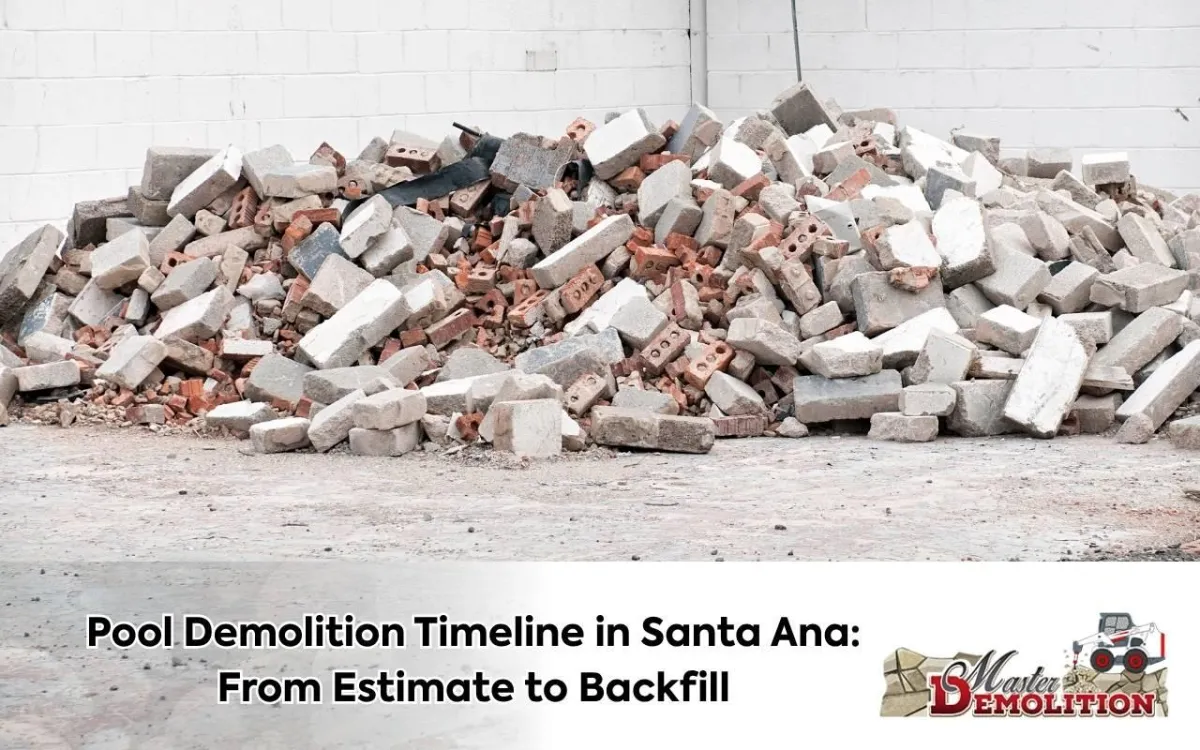
Pool Demolition Timeline in Santa Ana: From Estimate to Backfill
When your pool becomes more burden than benefit, it may be time for demolition. Understanding the pool demolition timeline in Santa Ana helps simplify the process. From estimate to backfill, each stage requires planning and compliance with local rules. This guide explains every step clearly, ensuring you feel prepared and confident throughout the project.
In Santa Ana, pool demolition involves more than just removing concrete. It requires proper permits, inspections, and suitable backfill material. With clear guidance, you can avoid delays and create a safe, versatile outdoor space.
Initial Consultation and Estimate Process
The process begins with a consultation where a demolition contractor inspects your pool. They check pool size, depth, and materials. Surrounding landscape and utility lines are also evaluated carefully. This inspection sets the foundation for your pool demolition timeline Santa Ana.
After inspection, the contractor creates a detailed estimate. This document includes labor, disposal fees, and equipment costs. It also provides a proposed schedule. Once a contractor is chosen, milestones and deadlines are confirmed.
Site inspection and measurements
Cost estimate with labor and disposal fees
Timeline discussion and milestone agreement
Securing Permits and Local Regulations
Before demolition starts, permits must be obtained from the Santa Ana building department. Applications usually include site plans and insurance proof. Approval may take up to three weeks. Starting early keeps the pool demolition timeline in Santa Ana on track.
Additional permits for disconnecting utilities are often required. Local codes demand inspections at several stages. Coordinating with the Building and Safety Division ensures compliance and prevents costly delays.
Submit permit application
Include site plans and contractor documents
Book required inspections early
Choosing the Right Pool Demolition Method
Contractors usually recommend between partial removal or full removal. Partial removal involves breaking the shell and filling it with soil. Full removal extracts every part, including rebar and plumbing. Although costlier, full removal avoids future settling problems. The chosen method impacts both cost and project duration.
Scheduling Demolition Day
With permits approved and method chosen, demolition is scheduled. This includes equipment delivery and crew assignments. Weather conditions are considered since heavy rain may cause delays. A well-planned schedule avoids downtime, keeping your pool demolition timeline Santa Ana on track.
Drainage and Water Disposal Considerations
Before demolition, water must be drained safely. Pool water often contains chemicals that cannot enter storm drains. Contractors pump, filter, and dispose of water according to regulations. Proper disposal ensures compliance and prevents site flooding issues.
Demolition Process: Breaking Down the Steps
The demolition phase starts with cutting and capping utilities. Heavy machinery breaks concrete into smaller pieces. Debris is then hauled away using dumpsters or trucks. Daily inspections confirm safety and help maintain progress.
Disconnect plumbing and electricity
Break down pool walls and floor
Remove and dispose of debris
Site Preparation for Backfill
Once debris is cleared, the site is prepared for backfill. Crews install drainage pipes and compact crushed stone. Each layer is carefully tested for stability. This prevents future soil settling and ensures a stable base for landscaping or construction.
Backfilling the Pool
Clean fill materials, like sand or crushed concrete, are used. Each layer is compacted before the next is added. Careful moisture monitoring ensures consistent density. This systematic approach strengthens the ground and avoids sinkholes. Scheduling deliveries helps keep the pool demolition timeline Santa Ana efficient.
Final Inspections and Site Cleanup
The city conducts a final inspection after backfilling. Inspectors review permits, drainage, and compaction results. Passing inspection closes the project officially. The contractor then completes cleanup, restoring the yard with soil, grass, or landscaping. A neat finish ensures safety and homeowner satisfaction.
FAQs about Pool Demolition in Santa Ana
How long does a typical pool demolition take?
Most projects take two to three weeks, depending on permits, inspections, and chosen demolition method.
Do I need a permit for pool demolition?
Yes, Santa Ana requires permits and inspections to ensure safe and compliant demolition.
Which method is better: partial or full removal?
Partial removal is faster and cheaper, but full removal prevents long-term settling issues.
What happens to the removed debris?
All concrete, rebar, and plumbing materials are hauled away and properly disposed of by contractors.
Can I build on the reclaimed space afterward?
Yes, with full removal you can safely build patios, gardens, or structures once the soil is compacted.
Transitioning to a Versatile Outdoor Space
After demolition, you gain valuable outdoor space. Options include gardens, patios, or play areas. Consulting landscapers ensures your vision aligns with soil and drainage conditions. Features like pavers or pergolas add beauty and functionality. Your once-problematic pool area now becomes a custom extension of your home.
Ready to reclaim your backyard? Learn more about our pool demolition services or explore concrete demolition options. For tailored assistance, contact our team today and start planning your transformation.